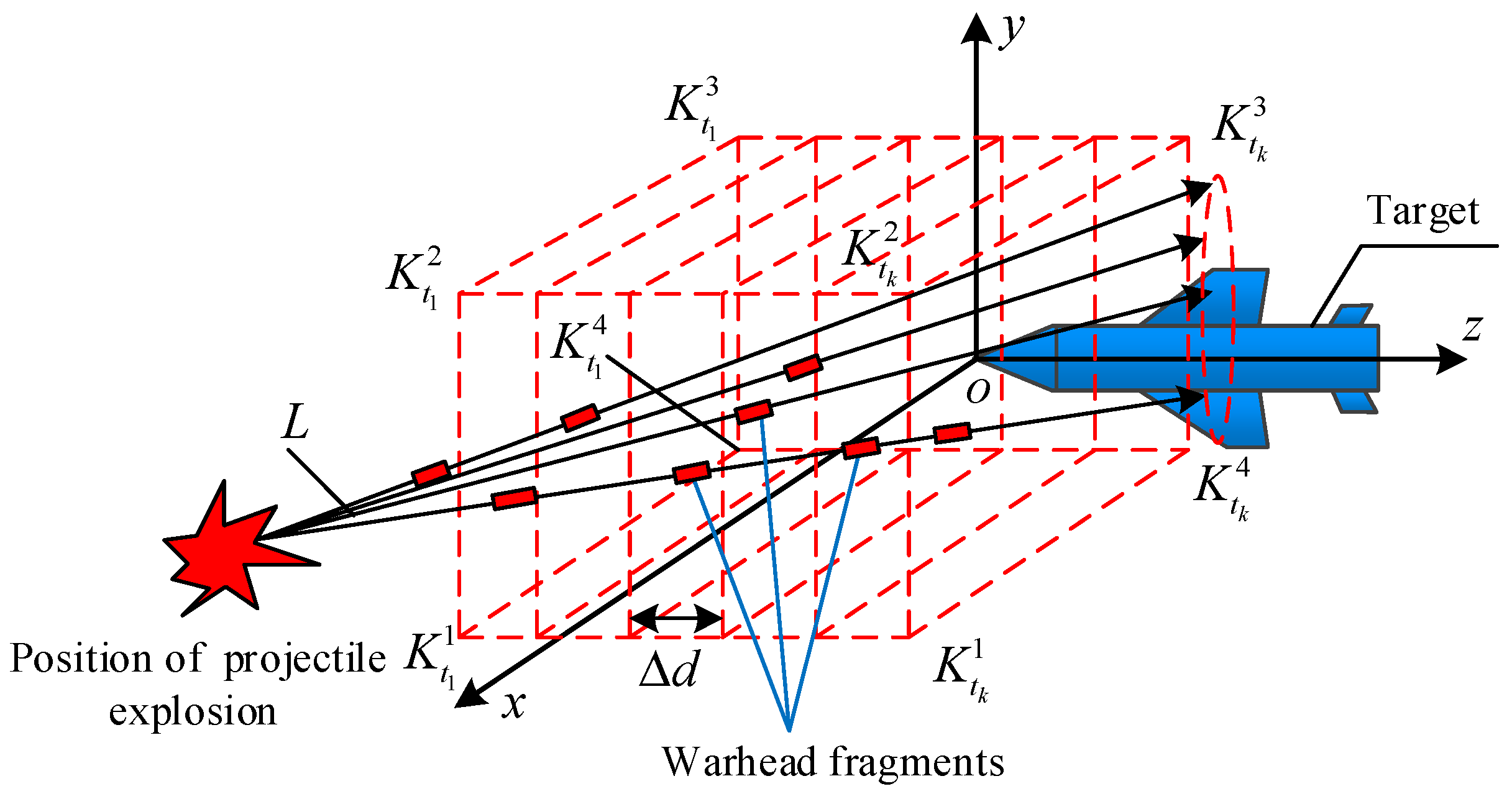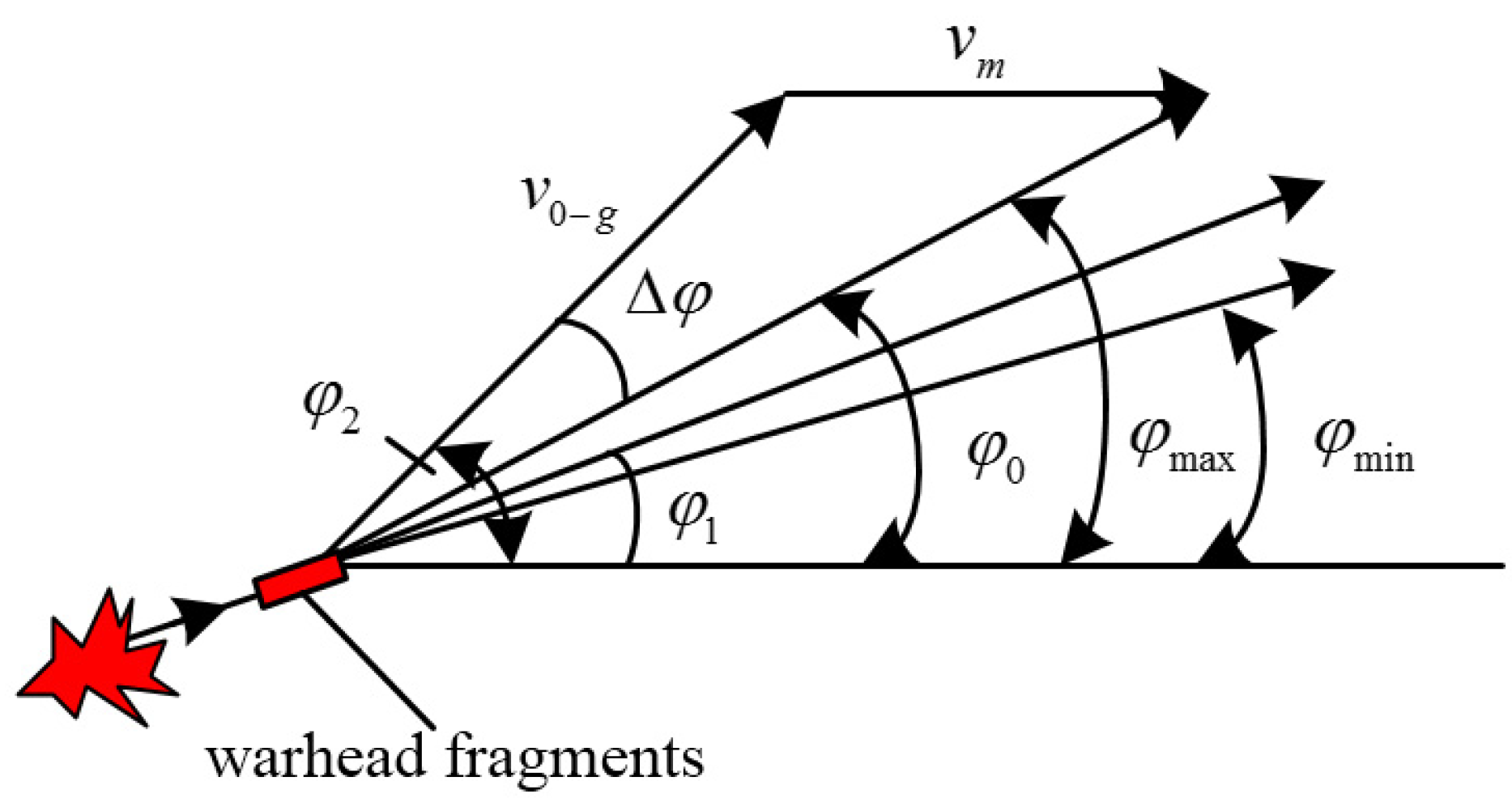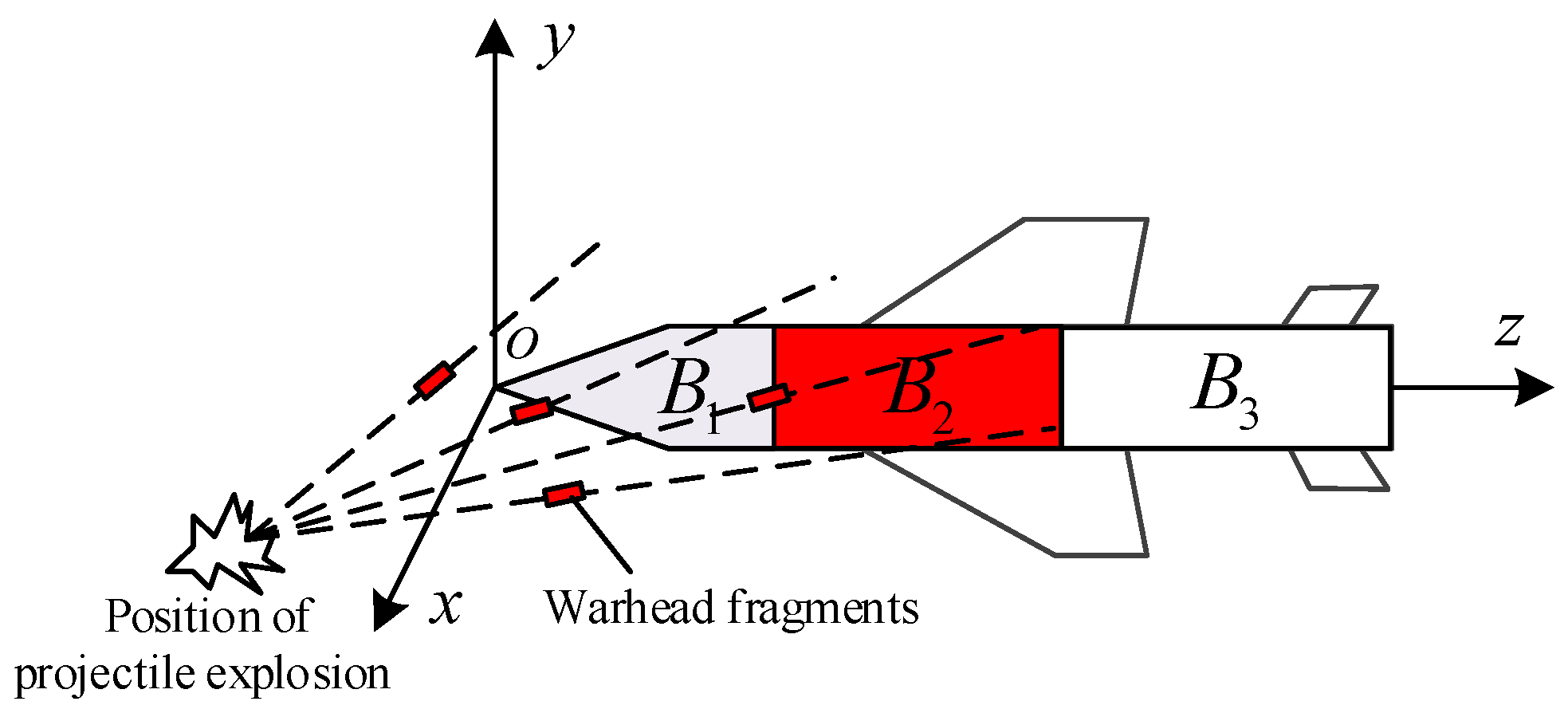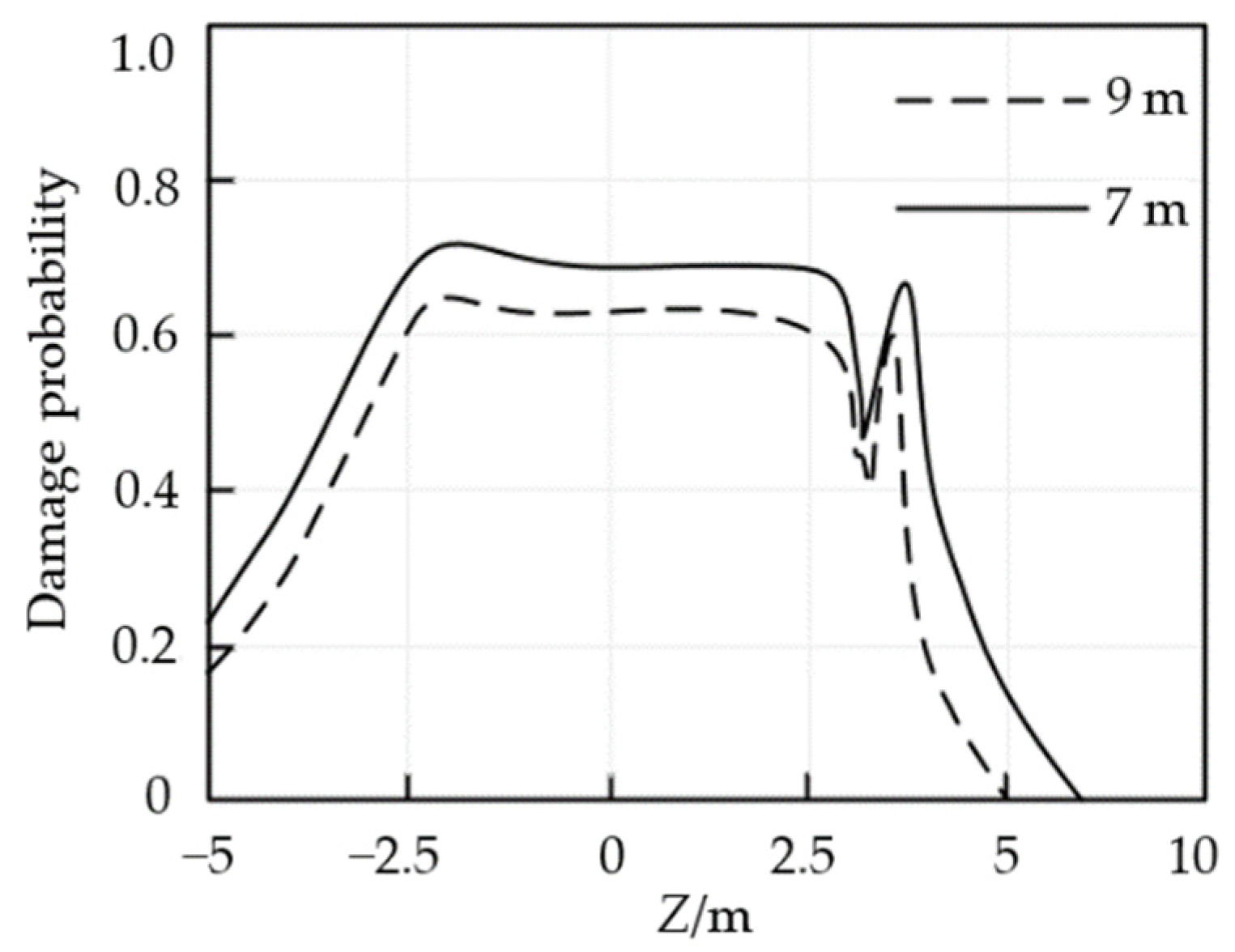1. Introduction
The proximity explosion damage caused by the intersection of projectile fuze to the missile is one of the important researching contents of fuze performance evaluation. Since the intersection attitude between the projectile fuze and missile in the air is random, and their intersection angle, position, attitude and weapon launch state are also uncertain, it is very difficult to accurately test the relative flight attitude of projectile and the explosion position of the projectile fuze under projectile intersects with the target in air. Therefore, it is impossible to use the direct test verification method to obtain the damage effectiveness of the projectile on the target (missile) [
1,
2]. At present, the damage effectiveness of the projectile to the missile is usually analyzed by simulation calculation or quantitative calculation of warhead fragments distribution that is formed by ground static projectile fuze explosion. There is no comprehensive method to obtain the damage effectiveness of the projectile on the missile under the intersection of the projectile fuze and missile. However, in a complex war environment, in order to make full use of battlefield resources and improve operational efficiency, it is necessary to comprehensively analyze and evaluate the killing weapons, which play a core role in the battlefield, so as to scientifically provide a decision-making basis for operational command. As a part of the battlefield, the damage effectiveness of the projectile to the missile is directly related to the threat of an incoming missile to our battlefield. So, how to maximize the formation of interceptor missiles in the air is an important mission for projectile fuze. The interception effect of the projectile fuze is reflected in the damage effectiveness under the intersection of the projectile fuze and the missile [
3].
The damage effectiveness of the projectile to the missile is different from that to ground, so it is impossible to obtain the calculation data required for damage assessment through the direct test method. However, many research studies on damage evaluation conducted by domestic or foreign scholars have achieved fruitful research results. For instance, Wang et al. [
4] first ascertained the position relationship between the intercept barrage and target projection on the surface of the barrage firing according to the characteristics of the metal storm weapon, comprehensively considering the errors of fire data, errors of target point, and errors of dispersion of metal storm weapon, then established the damage probability model of the metal storm weapon. By analyzing the uncertain information of battle damage, Chen et al. [
5] presented the battle damage assessment problem in an uncertain information environment and then established the battle damage assessment function. For the impact of complex and uncertain factors in modern battlefield environment, Qu et al. [
6] put forward a new damage assessment method based on the BN-Cloud model. Xu et al. [
7] gave the damage levels and damage criterion of every component of the missile based on the function, structure and damage mechanism of the missile. Based on the definition of target damage ability, Zheng et al. [
8] implemented a new grey clustering evaluation model and used the model to evaluate the target damage ability of air defense weapon. Wu et al. [
9] put forward a damage assessment model based on an adaptive neuro-fuzzy inference system; this method used the position of the artillery projectile to attack the target as the input of a fuzzy neural network, and utilized the Takagi–Sugeno principle to calculate the damage effect of the target, but this method needs to know the precise data of the target being hit. Aiming at the problem of the reliability and certainty of the damage information in the assessment of artillery long distance firepower damage, Liu et al. [
10] introduced the dynamic Bayesian network (DBN) to estimate the effect of the damage. In [
11], the author studied the method of structural damage assessment based on the structural characteristics of the damaged target, according to the structure characteristics of the target, and used the target feature points to evaluate the damage effectiveness. In [
12], Li et al. researched a target damage assessment based on the detection information; this method analyzed the basic principle of battle damage assessment by using the target characteristics detection information.
In terms of damage assessment research at the intersection of projectile and target, in reference [
13], a comprehensive performance analysis system for numerical simulation of the blast-fragmentation warhead power field was investigated in terms of damage evaluation at the intersection of the projectile and target. Wang et al. [
14] used the shot-line method to establish the fragment trajectories, set up the damage assessment model of a blast-fragmentation warhead against a ground target that satisfies the functional requirements of warhead simulation. Tian et al. [
15] investigated the effect of proximity fuze explosion point by using the fuze real-time explosion point statistical model. Additionally, Si et al. [
16] researched a method for assessing the damage of warhead fragments against airplane targets, analyzed the relationship between component damage and airplane damage via a tree diagram, and calculated the damage probability of airplanes.
Most of the methods are based on the known characteristic parameters to consider the target damage calculation; however, for the damage assessment that formed by the intersection of projectile fuze and target in the air, it is difficult to obtain more accurate target damage information. This kind of information is mathematically expressed as uncertain, incomplete or fuzzy information, which is difficult to analyze the space damage effectiveness of projectile and target. Based on the uncertain dispersion characteristics of warhead fragments formed by projectile explosion and target damage level, this paper establishes a mathematical model on target damage effectiveness evaluation under uncertain information of warhead fragments, and studies the numerical calculation method for target damage effectiveness evaluation of warhead fragment group by using the multi-layer warhead fragments distribution division mechanism. The main work and contributions of this paper are as follows:
- (1)
We propose a calculation method for evaluating the target damage effectiveness based on time interval multi-layer warhead fragments distribution with uncertain information. By analyzing the distribution characteristics of multi-layer warhead fragments and the intersection characteristics of warhead fragments and target, we establish the damage criteria of target components.
- (2)
We establish the membership function of damage factors and the evaluation model of target damage level by using fuzzy prior probability theory and construct the damage level evaluation method of different targets by using the stochastic multi-criteria acceptability analysis method.
- (3)
We form a numerical calculation method of target damage effectiveness by using the ratio of the effective area of warhead fragment group attacking target and the area of target itself, as well as the effective number and the area ratio of the warhead fragment penetrating target.
2. Materials and Methods
In the target damage test of the weapon shooting range, for the damaged target, such as missiles, drones, armored vehicles and so on, they are often placed a position where the distance between the munition (projectile) forming the power of warhead fragments and damaged target is
L, as shown in
Figure 1. For the space damaged target, the projectile and the damaged target form a state of intersection and confrontation; in this paper, we refer to the damaged target collectively as the target.
This paper mainly explores the damage effectiveness of warhead fragments formed by directional projectile fuze explosion on the target. There is a certain distance between the projectile and the target. This distance is the relative position between the projectile explosion position and the target, and it is a random distribution due to the different timing of the projectile fuze detonation control. In order to scientifically establish the damage effectiveness in the state where the projectile and the target meet in space, we take the head of the target as the central origin of the coordinate and record it as , and the coordinate system is oxyz. We assume that the position of the projectile explosion is , and , which is the distance between the projectile explosion position and the target. The warhead fragments group formed by the projectile explosion is often in a conical dispersion state. It is not difficult to find that the projectile attack posture at the moment of projectile explosion is different, and the intersection state of warhead fragments and target is also different, which is obviously a random uncertain state. The power energy of the warhead fragments decreases with the increase in distance in the process of warhead fragment dispersion. When the power energy of warhead fragments intersecting with the target is greater than the kinetic energy of penetration required by the target, the target loses combat effectiveness and the target is regarded as damaged. In order to scientifically evaluate the target damage effectiveness, it is necessary to calculate the effective number of warhead fragments hitting the target and the damage area of the target. Because the dispersion state of warhead fragments and the number of effective warhead fragments are uncertain, the target damage effectiveness belongs to uncertain random probability.
Regarding the target as a cylinder with a diameter of d1 and a length of d2, and assuming that the dispersion plane of projectile explosion is at time and the fragment dispersion plane is at time . We divide the warhead fragment dispersion into k planes with a certain thickness, which are , the thickness is . For a single target, the warhead fragments which can intersect with the target in the plane area are used as the effective attacking warhead fragments. Since the dispersion and quantity of warhead fragments are different at each time, and the hitting target position of the effective warhead fragments is also different, it is difficult to intuitively use the same function as the standard. From the intersection of warhead fragments and target in each layer, they are independent of each other. In order not to lose generality, we regard the damage effectiveness formed by the warhead fragment group formed at each time independently attacking the target as the damage effectiveness of the warhead fragment on the target at a single time, and the total target damage effectiveness is determined by the warhead fragments group at k times. At the same time, in order to calculate the damage effectiveness of the target, we divide the cylinder target into m vulnerable areas, and set the factor weight of the j-th vulnerable part as , . Therefore, the damage effectiveness of projectile on a single target can be attributed to the target damage under the dispersion of k plane warhead fragments. Set the damage probability of the l-th plane as Pl, then the total target damage probability is .
According to
Figure 1, the warhead fragments formed by projectile explosion are symmetrically and evenly distributed along the circumferential direction of the target. The warhead fragment formed by the projectile explosion has a certain divergence angle, as shown in
Figure 2.
In
Figure 2,
and
are the static minimum and maximum flying directions of warhead fragments,
is the scattering angle of the warhead fragments
is the static flying angles of the warhead fragments when the target’s end velocity is superimposed, the dynamic interval angle of the warhead fragment is calculated using formula (1).
where
is the static initial velocity of the
g-th warhead fragment formed by the projectile explosion, and
is the terminal velocity of the target. The velocity of the warhead fragment can be expressed by Formula (2).
where
is the flight velocity of the
g-th warhead fragment, and
is the scattering angle function of the warhead fragment.
Assuming the number of warhead fragments in the
j-th layer is
, the total number of warhead fragments is
. We use the ray method to calculate the intersection attitude of the warhead fragment field and the target, namely, discretize the warhead fragments in the warhead fragment field into
N rays emitted by the projectile explosion position to simulate the flight trajectory of warhead fragments. The circumferential and axial angle values of the discretized element can be expressed by Formula (3).
where
and
are the circumferential and axial angle values of the discretized element of the
j-th layer warhead fragment, respectively.
and
are the leading edge and trailing edge angles of the
j-th layer warhead fragment dynamic dispersion respectively, and warhead fragment dispersion lines are randomly formed in each discretization unit.
K is the number of axial layers.
From the above analysis, we know that the projectile explosion position is an unfixed parameter relative to the target, which is called uncertain position information; at the same time, because of the different intersection attitude of the projectile and the target, the warhead fragments formed by the projectile explosion are also different in the location of the target surface, which leads to the change of the critical part of the warhead fragments hitting the target. Therefore, it is necessary to establish a criterion model for the damage of the vital part of the target. In addition to the target’s own inherent vulnerability parameters, there are many uncertain parameters related to the target damage effectiveness, such as the distance between the projectile explosion position and the target, the position where the warhead fragments shoot to the target, the dynamic flight state of the warhead fragments, etc. These parameters belong to an uncertain state in value, so the damage effectiveness of warhead fragments to target is a kind of damage evaluation with uncertain information. In the weapon damage test, it is very difficult to obtain comprehensive evaluation parameters of the target damage. Therefore, in this paper, we adopt the fuzzy membership function, damage factor weight, target damage level to set up the damage evaluation effectiveness.
5. Mathematical Calculation of Target Damage Probability by Warhead Fragments
From the intersection process of warhead fragments and target in
Figure 1 and
Figure 2, we know that to determine the effective damage of warhead fragments to the target, it is necessary to analyze the number of warhead fragments hitting the target, and the location of hitting the target (i.e., flammable, explosive and other components); additionally, the damage weight is determined according to the established target damage level. According to the intersection state between the
k layer warhead fragments and the target at different times, and by using the shoot-line method to simulate the penetration process of the intersection between each warhead fragment and the target, the damage level of the hitting key components and the number of effective warhead fragments are calculated.
Combined with the number and area of warhead fragments attacking the target component, set up that the probability of damage of the target component under the random attack of the
-th single warhead fragment is
, and the probability that the target component is hit and damaged by
independent random effective warhead fragments is
.
can be obtained by Formula (18).
where
can be expressed by Formula (19).
where
is the vulnerable area of the component under the
warhead fragment attack, and
is the total area of the component. Then the probability
that the target component is hit and damaged by
independent random effective warhead fragments can be calculated by Formula (20).
Since the target is composed of three components, namely flammable components, explosive components and other components, according to Formula (16), the total damage probability of the target is determined by three components. Set up that the total damage probability of the target is
, and then Formula (8) is transformed to Formula (21).
Formula (21) represents the damage accumulation of three vulnerable components of the target itself, and each vulnerable type component contains its own target damage level.
6. Analysis of Numerical Results
According to the established theoretical model and calculation method, taking a missile as an example, calculate and analyze the damage effectiveness of a single target. The projectile explosion produces 1050 prefabricated warhead fragments; the mass of a single warhead fragment is 5 g; the face-to-face cross-sectional area of the warhead fragment is 19.6 mm
2; the initial velocity of the warhead fragment is 1200 m/s; and the front and rear edge angles of warhead fragment dynamic dispersion are 20° and 28°, respectively. The horizontal height difference between the explosion position of projectile and the target is set as 1.5 m. The warhead fragments layer formed by the projectile explosion is set to 6 layers, combined with the time
, the corresponding number of per layer’s warhead fragments is recorded as
, and the number of warhead fragments
are 50, 100, 150, 200, 250, and 300, respectively.
Figure 3 shows the intersection of the projectile and target segmentation area. The target is considered relatively stationary, and the distance between the projectile explosion position and the target is relatively short, so the decay of the warhead fragment velocity is not considered in this paper.
In
Figure 3, the target is divided into three vulnerable components: flammable components, explosive components, and other vulnerable components. Their damage weight is denoted as
respectively. According to the lateral coordinate system
of the target,
is the central position of the head of the target, and the direction
is the lateral length of the target. According to the length of three vulnerable components, record the effective length range of them in the direction
by meters,
,
and
. The total number of warhead fragments hit in areas
,
and
are
,
and
respectively. Under the condition that the numbers of warhead fragments are
,
and
, and according to the proportion of the number of warhead fragments being 2:1:2 in areas
,
and
respectively, we can calculate the target damage probability with the distance between the projectile explosion position and the target as 7 m and 9 m, respectively.
Figure 4 shows the calculated damage probability results under different distance.
According to the calculation results in
Figure 4, it can be seen that when the distance between the projectile explosion position and the target is relatively short, the damage probability of the corresponding vulnerable parts is relatively high, which is mainly reflected in the following:
- (1)
When the distance R between the warhead fragment and the target at the time is small, the number of warhead fragments acting on increases. On the contrary, the number of warhead fragments acting on the three parts decreases. According to the calculation of Formulas (18)–(21), the damage probability of each part also decreases.
- (2)
About the intersection conditions between warhead fragments and target, warhead fragments are scattered in a certain range, and those warhead fragments which intersect with the intersection effective area of target have damage ability.
- (3)
For the three components , due to the different vulnerable weights, the damage results of the three parts are also different under the penetration of the same number of warhead fragments. It is not difficult to find that the damage weight of is the largest, and the damage probability is the largest, the second is . belongs to other vulnerable parts, and even if there is the same number of warhead fragments’ intersection with in , due to the small damage weight of , the damage probability caused by the fragments in this part is also very small.
In order to scientifically evaluate the damage effectiveness of the target, for three components
, the target damage evaluation method under uncertain information is introduced. According to Formulas (11)–(17), the comprehensive damage effectiveness of three components is divided into five levels, that is
, the damage level description as shown in
Table 1.
Assuming that the prior information is
, the target damage factor of the three components is
, and the uncertain damage information matrix is
According to Formula (11), the membership function of the damage factor can be calculated. The weight of the damage factor is
. If the damage weight meets
, the weight space will be
. According to the damage level probability statistical index, the central weight vector index and the probability statistical index of damage level based on the central weight vector, the parameter values of the target damage level based on
are calculated,
Table 2 is the calculation result when
.
It can be seen from
Table 2 that the index
is the largest, that is, the probability statistical index
of the target damage level under this condition is also the largest, and the probability statistical index of the damage level based on the central weight vector is also the largest. It shows that under the condition of the calculated damage probability, the current target damage level belongs to
.
Based on the numerical value of the uncertain damage information matrix, assuming that the prior information is
, the prior probability values of each damage level are equal. We adjust the damage factor weights, and
, the weight space meet
. We recalculate the damage level probability statistical index, the central weight vector index and the probability statistical index of damage level based on the central weight vector,
Table 3 is the calculation result when
.
It can be seen from
Table 3 that the index
is the largest, and the probability statistical index of the damage level based on the central weight vector is also the largest. It shows that under the condition of the calculated damage probability, the current target damage level belongs to
.










